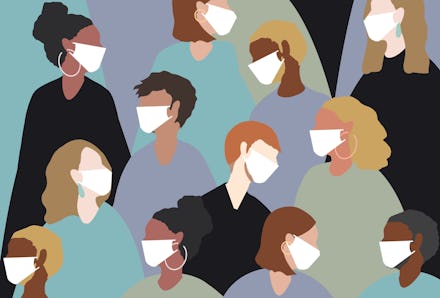Why you don't need to freak out about breakthrough infections

For me, getting the jab in May felt like buckling a seatbelt. Sure, I still needed to be careful, but it let me move through the world with way more confidence than I could last year. Like many people, though, I worried that the Delta variant would rip that seatbelt right off. My sister came down with a breakthrough infection in July, and reports surfaced soon after of an outbreak in Provincetown, Massachusetts, where three-quarters of those who tested positive were fully vaxxed. While I know vaccination protects me from severe illness and death, I’d rather just not get sick at all.
But it turns out even the risk of that is low, according to the New York Times. Infection data reveal that the average vaccinated American has around a 1 in 5,000 chance per day of getting COVID. Let's break down what this means.
First, the good news: The 1 in 5,000 figure is even lower for those who are extra careful or live in a community with a high vaccination rate. Even though Delta is highly contagious and has upped the risk of infection for almost everyone, the Times noted, it's still low for vaccinated people, and the risk of serious illness lower still.
The Times drew these numbers from Utah, Virginia, and King County (which includes Seattle) in Washington State, which have all recorded infections by vaccination status. The risk of breakthrough infection is higher in the Southeast and other places with bad outbreaks, and lower in places with far smaller case counts like the Northeast, possibly to below 1 in 10,000. Put another way — since 1 in 10,000 isn’t that intuitive — the cumulative risk would take more than three months to hit one percent.
What really seemed to spark worries about breakthrough infections was the CDC’s report in July that vaccinated people infected with the Delta variant harbored about the same viral load in their noses and throats as those who hadn’t gotten the shot, the Times said. But in fact, “the same viral load” doesn’t equate to “the same risk of infection.”
While unvaccinated people are totally vulnerable to the viral load, the Times explained, vaccinated people’s immune systems have been trained to mount a swift, robust response to it, usually before they even get sick or spread the virus. In other words, the observation that vaccinated people infected with Delta have the same viral load as their unvaccinated counterparts doesn't really matter. Plus, COVID looks like a mild flu in vaccinated people, raising questions about how much we even need to worry about breakthrough infections.
Yet amid the collective trauma of the pandemic, anxieties understandably remain high, the Times reported, especially in more progressive communities. A poll conducted by ABC News and the Washington Post found that even though 75% of adults have received at least one dose, half viewed their risk of getting COVID as moderate or high.
None of this is to say that vaccinated people should throw caution to the wind. But it does suggest that those of us who are freaked out by breakthrough infections can afford to chill. “The messaging over the last month in the U.S. has basically served to terrify the vaccinated and make unvaccinated eligible adults doubt the effectiveness of the vaccines,” Monica Gandhi, an infectious disease specialist at the University of California, San Francisco, tweeted last Friday.
In reality, the COVID risk for the average vaccinated person is probably closer to those we accept on a daily basis, per the Times, like, say, riding a car. While everyone has a different threshold for risk, tethering it to the actual numbers is important. As a naturally anxious person, I totally get the temptation to be hypervigilant. But as a science-minded person, I also believe in letting the data guide our choices — and so far, the data says the vaccines are extremely effective at protecting us from COVID.